Dogs with healthy bodies do a great job at fighting off infections–but sometimes their immune systems can’t handle the infection, and your pup gets sick.
While we never want to see our fur babies hurt or ill, it’s important to know the signs so that they get timely vet care–and make speedier recoveries.

Types of bacterial infections in dogs include salmonella, leptospirosis, staph infection, ear infection, actinomycosis, streptococcus, bordetella, E. coli, and clostridia. Symptoms range from
In this article, we’ll discuss all of the infections listed above, their symptoms, how they’re treated, and more.
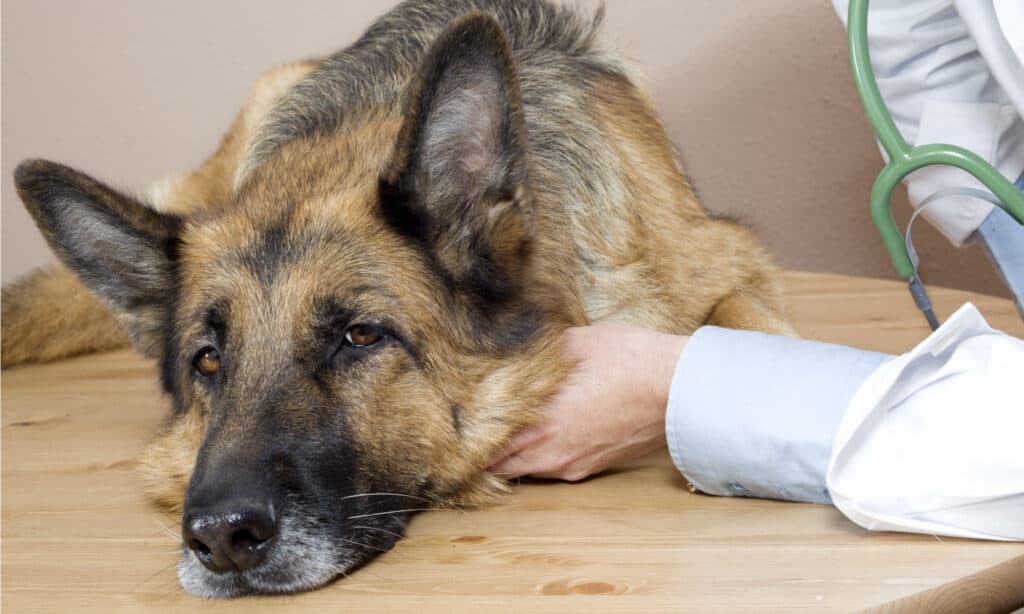
While we never want to see our fur babies ill, it’s important to know the signs so that they get timely vet care–and make speedier recoveries.
©Roger costa morera/Shutterstock.com
1. Salmonella

Veterinarians typically diagnose
salmonella infections
based on their symptoms and by taking cultures.
©nobeastsofierce/Shutterstock.com
Dogs can get salmonella infections from contact with infected animals’ feces, contaminated food or water, and raw or undercooked meat.
Symptoms of Salmonella infection include:
- Diarrhea with blood or mucus
- Lethargy
- Fever
- Shock
- Vomiting
- Decreased appetite
- Weight loss
- Dehydration
- Skin disease
- Increased heart rate
- Swollen lymph nodes
- Abnormal vaginal discharge
- Gastroenteritis
- Miscarriage
- Sepsis
- Blood loss
- Infections
Some dogs don’t get sick at all from salmonella, while others have severe symptoms. Those who aren’t ill can still be carriers for the illness, passing it to other animals or people through their feces.
Veterinarians typically diagnose salmonella infections based on their symptoms and by taking cultures. Salmonella can be difficult to cure, but vets will typically use a combination of antibiotics and other care to treat the dog’s symptoms. Many dogs who do show symptoms are hospitalized.
2. Leptospirosis

Dogs are infected through the fluids of other infected animals and may catch leptospirosis through contaminated water or dirt.
©praditkhorn somboonsa/Shutterstock.com
Leptospirosis is caused by the spirochetes bacteria. Dogs are infected through the fluids of other infected animals and may catch leptospirosis through contaminated water or dirt, being bitten by an infected animal, or, rarely, through mating with an infected dog.
Humans can also be infected, and may be at risk if you’ve swam in the same body of water as your dog who’s just been diagnosed, for instance. You’re unlikely to catch leptospirosis from your dog directly so long as you practice good hygiene and your dog doesn’t bite you.
Symptoms of leptospirosis in dogs include:
- Fever
- Lethargy
- Depression
- Vomiting
- Redness in the nose or mouth
- Kidney inflammation
- Kidney damage
Puppies are most at risk of severe illness.
Leptospirosis is typically treated with antibiotics. There is also a leptospirosis vaccine for dogs which reduces their odds of contracting it.
If your dog goes outside at all, even just in the backyard, most veterinarians recommend they get a leptospirosis vaccine at 16 weeks and 20 weeks of age, followed by yearly boosters.
3. Staph Infection

It’s a good idea to wash your hands after petting your dog if they do have an infection, just in case!
©Benjamin Clapp/Shutterstock.com
Staph infection is caused by the staphylococcus bacteria. It affects the skin and respiratory system and is typically caused by excessive itching.
This is another infection that can be spread to humans, but it’s very rare, especially when practicing good hygiene. It’s a good idea to wash your hands after petting your dog if they do have an infection, just in case!
Symptoms of staph infection in dogs include:
- Hair loss
- Wet skin
- Crusty skin
- Peeling skin
- Redness
- Inflammation
- Pain
- Itchiness
- Pus-filled skin lesions
- Eye, skin, ear, or respiratory system infections
Treatment can include antibiotic shampoos to treat skin symptoms and oral antibiotics for the respiratory system. If your dog has an underlying condition that caused the staph infection, such as fleas or allergies, your vet will also want to treat these so that the infection doesn’t return.
4. Ear Infection

Dogs get ear infections for a variety of reasons.
©iStock.com/didesign021
Ear infections can be either bacterial or fungal, but most often they are bacterial. Dogs get ear infections for a variety of reasons, including allergies, trapped fluid, ear wounds, and ear mites. Some breeds are more prone to ear infections, such as those with long, droopy ears.
Symptoms of ear infections in dogs include:
- Redness
- Inflammation
- Itchiness
- Head shaking
- Abnormal ear discharge
- Crusts or scabs in the ears
- The odor from the ears (typically described as yeasty or cheese-like)
Most ear infections are simple to treat by cleaning the ears and using either antibiotic ointment or oral medications. Sometimes, more aggressive treatment is needed to fight severe infections. In rare cases, the dog’s ear canal may need to be removed surgically.
If you think your dog has an ear infection, get to the vet as soon as you can prevent it from spreading and becoming more serious.
5. Actinomycosis

Always keep your
dog’s wounds clean
.
©iStock.com/photoboyko
Actinomycosis is caused by Actinomyces and Nocardia bacteria. Dogs are most commonly infected when an open wound makes contact with infected soil.
Symptoms of actinomycosis infection in dogs include:
- Abscesses beneath the skin
- Pneumonia
- Inflammation around the lungs
- Infections of the nervous system
Dogs are treated using antibiotics, and treatment is most successful when the infection is localized (meaning it’s only affecting the skin near the wound).
Always keep your dog’s wounds clean. Soap and water are effective, but bandaging isn’t typically recommended as it’s easy to pull bandages too tight and cut off circulation–thus doing more harm than good.
See a vet if the wound is severe or if your dog has a puncture wound, such as a bite from another animal. Also see a vet at the first sign of infection, as waiting can cause it to worsen or spread.
6. Streptococcus
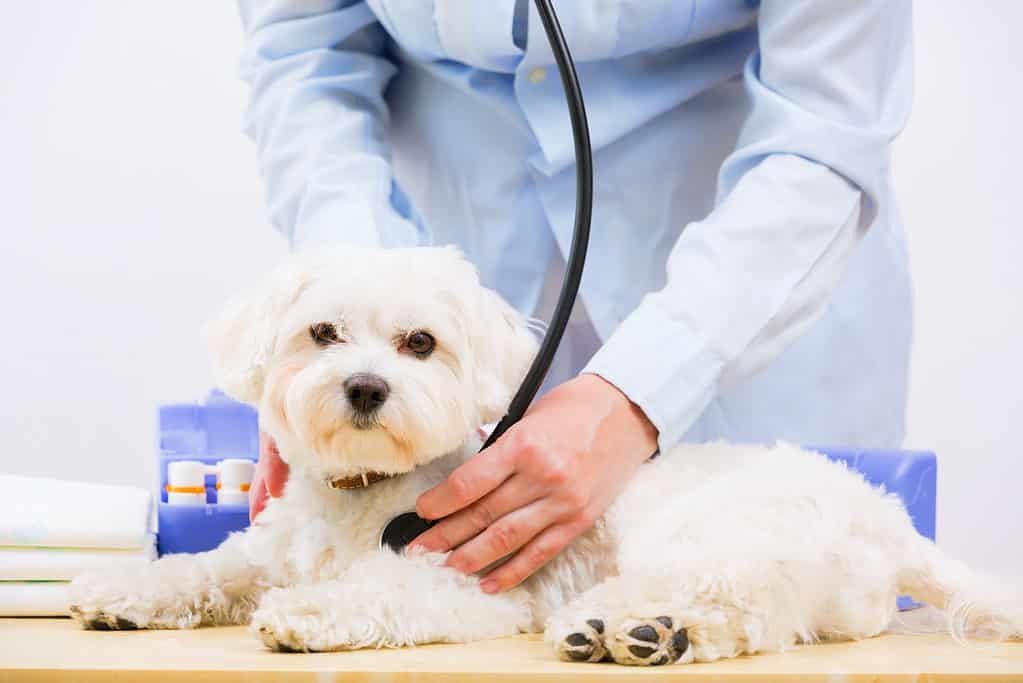
Your veterinarian will likely prescribe antibiotics after diagnosing your dog with Streptococcus.
©gorillaimages/Shutterstock.com
Streptococcus, or strep, is what causes strep throat. Luckily, the bacteria that cause strep in humans and dogs are different, so it’s extremely rare for your dog to pass it to you or vice versa.
Symptoms of strep throat in dogs include:
- Swollen throat
- Difficulty swallowing
- Coughing
- Gagging
- Fever
- Tiredness
- Decreased appetite
- Dehydration
Your veterinarian will likely prescribe antibiotics after diagnosing your dog with Streptococcus. They may also recommend that your dog rests as they recover.
While strep isn’t passed from dogs to people, it can be passed to other pets, so please isolate your dog from other pets if they’re infected. You should also monitor your other pets for signs of illness and bring them to the vet if needed.
One way to prevent strep is to provide your dog with good dental hygiene. The best way is through brushing their teeth daily, but chews are a good runner-up when it comes to effectiveness.
Ask your veterinarian if your dog needs a professional cleaning as well. These are typically recommended around once a year.
7. Clostridia

If your dog has clostridia, your veterinarian might recommend dietary changes, probiotics, and antibiotics.
©Kuznetsov Alexey/Shutterstock.com
Clostridia is thought to be the cause of up to 20% of diarrhea cases in dogs. It can be acute (short-lasting) or chronic (recurring every 4-6 weeks for months or even years).
Symptoms of clostridia in dogs include:
- Blood or mucus in diarrhea
- Difficulty pooping
- Vomiting
- Flatulence
- Stomach pain or discomfort
- Lack of growth or abnormal development
They may have small bouts of diarrhea that occur frequently or have large, watery stools.
If your dog has clostridia, your veterinarian might recommend dietary changes, probiotics, and antibiotics. In extreme cases, hospitalization may be needed.
8. Bordetella
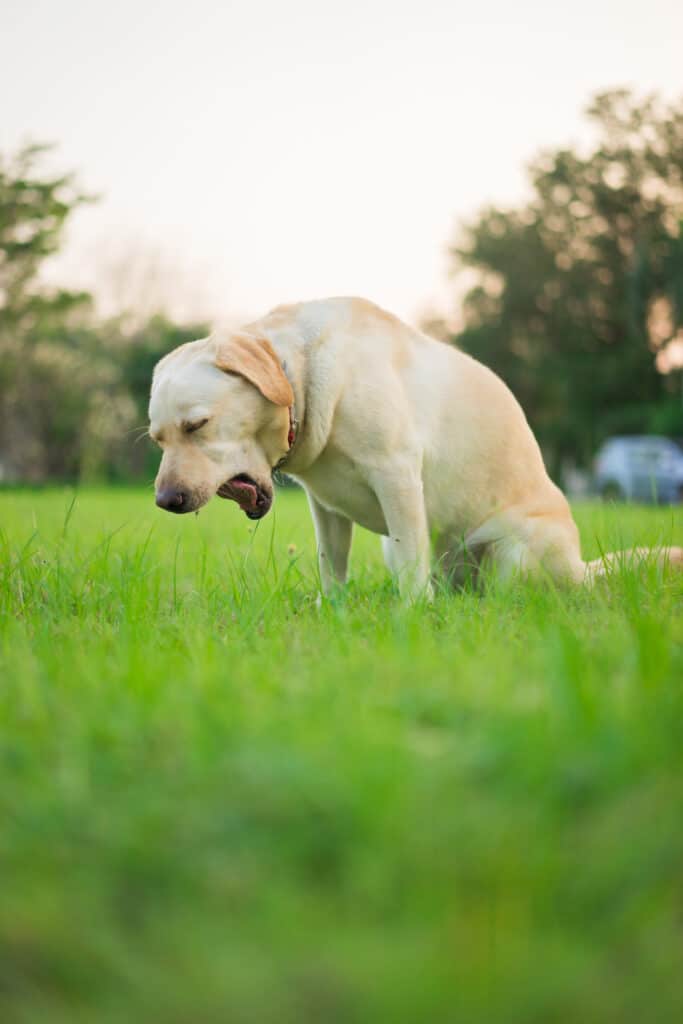
Bordetella is highly contagious and frequently spreads in crowded environments like shelters and dog boarding facilities.
©Dhanoo Surasarang/Shutterstock.com
This infection causes kennel cough, also known as an upper respiratory infection (URI). It’s highly contagious and frequently spreads in crowded environments like shelters and dog boarding facilities.
Symptoms of Bordetella infection in dogs include:
- Sneezing or coughing
- Runny nose
- Eye discharge
- Congestion
- Fever
- Decreased appetite
Bordetella is typically treated using antibiotics, though other treatments may be used as well depending on your dog’s symptoms.
The Bordetella vaccine limits the severity of the infection and prevents infection altogether in many dogs. While it isn’t a core vaccine, it’s recommended for dogs that frequently spend time around others, especially in crowded places like dog parks or boarding facilities.
Another way to avoid Bordetella infection is to avoid crowded environments and allow your dog to play dates with other vaccinated dogs instead of bringing them to daycare or dog parks. Socializing only with known dogs also reduces the risk of dog fights and your dog catching other contagious illnesses.
Poor ventilation, cold temperatures, dusty environments, stress, and smoke exposure also increase your dog’s chance of catching kennel cough. So when it comes to the places you visit with your dog, choosing a clean facility that isn’t overcrowded is the best way to go. If dogs are socializing, choose a facility that requires the Bordetella vaccine for all dogs.
9. E. Coli

Puppies may develop an E. Coli infection if their mother is infected, or if they fail to drink their mother’s first milk which protects them against infections.
©frank60/Shutterstock.com
E. Coli typically lives in every dog’s intestines and doesn’t cause symptoms or illness. However, if the bacteria becomes too widespread, it can cause serious problems for your dog. This happens most commonly in puppies or dogs with compromised immune systems.
Puppies may develop an E. Coli infection if their mother is infected, or if they fail to drink their mother’s first milk which protects them against infections. They’re most likely to get sick in unclean or crowded environments, or if the mother has poor health or nutrition.
Symptoms of E. Coli infection in dogs include:
- Sepsis
- Depression
- Dehydration
- Decreased appetite
- Vomiting
- Increased heart rate
- Weakness
- Tiredness
- Diarrhea
- Low temperature (cold skin)
- Blue skin around the mucous membranes (gums, nostrils, ears, and anus)
Often, dogs with E. Coli must be hospitalized as it’s an emergent condition. Most puppies, unfortunately, don’t survive this infection.
Preventing Bacterial Infections In Dogs
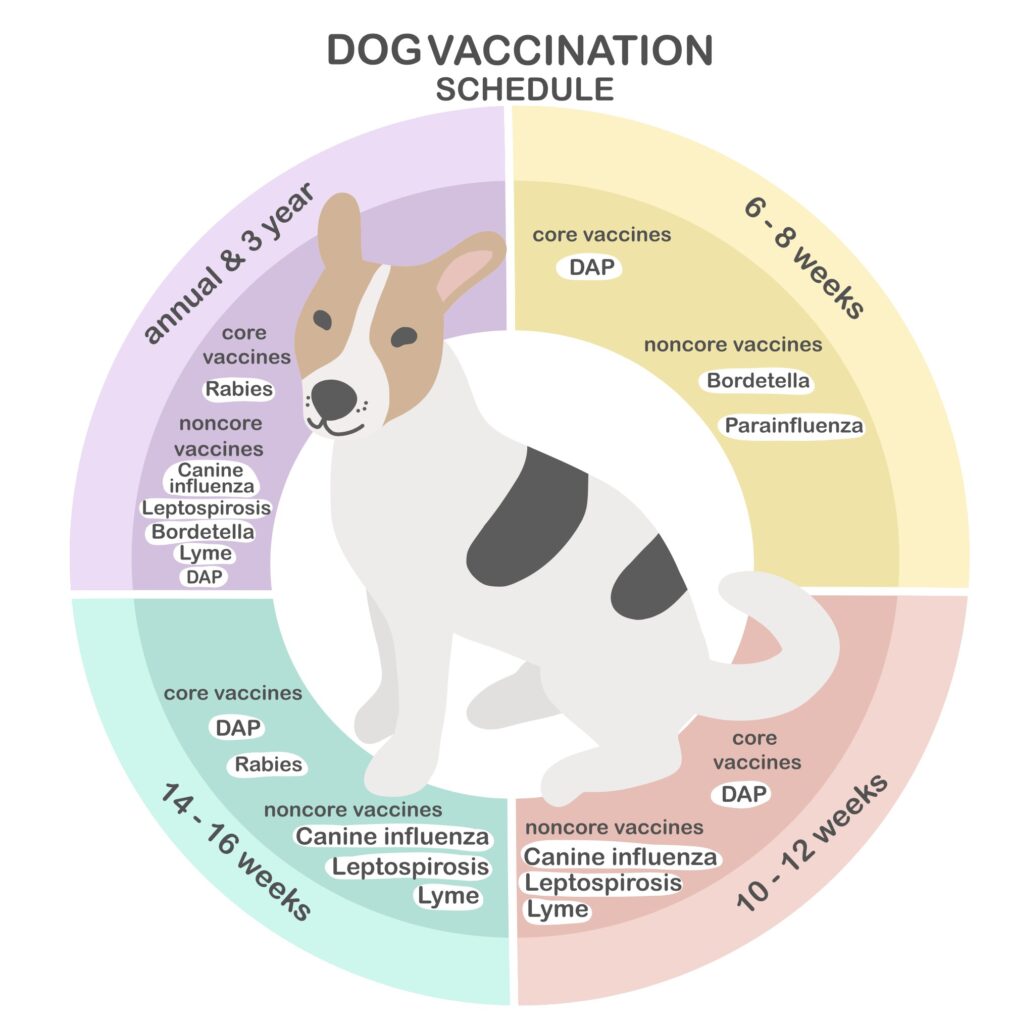
Some of the infections above have vaccines that drastically decrease your dog’s chances of infection.
©AmySachar/Shutterstock.com
Preventing bacterial infections in your dog takes several steps, but luckily most of them are pretty easy!
Prevent Injuries
First, keeping your dog from getting out of the house or yard prevents injuries that can become infected. It’s also a good idea to keep your dog away from unknown dogs, as this increases their risk of getting into a fight.
Even if your dog wouldn’t hurt a fly, it can be injured by another dog. Bite wounds become infected very easily because they tend to be deep with small openings. The skin heals quickly, trapping bacteria inside the wound.
Keep Wounds Clean And Dry
If your dog is injured, be sure to keep the wound clean and dry. Use soap and water to clean the cut, repeating as necessary if it becomes dirty from going outside.
Bandaging the wound doesn’t often work well, because many dogs will rip the bandage off. It’s also easy to wrap bandages too tight, which can cut off your dog’s circulation.
If your dog has a severe wound and you’re worried about infection, see a vet rather than trying to wrap it yourself.
See A Vet Sooner Than Later
Often, veterinarians will prescribe antibiotics as a preventative measure if your dog has a wound. This can stop infections from developing altogether.
It’s also important to get your dog to the vet quickly if you notice symptoms of an illness or infection, or even if they just aren’t acting like themselves.
When left untreated, infections will often spread. The more widespread they become, the harder they are to treat and the worse your dog’s prognosis may be.
Quick veterinary treatment can also help prevent an illness, like allergies, from becoming an infection, like an ear or staph infection.
Vaccinate Your Dog
Some of the infections above have vaccines that drastically decrease your dog’s chances of infection. Many vaccines will also limit the severity of the symptoms if your dog is infected.
Keeping them up to date on these vaccines is important, especially if your veterinarian considers them at risk of catching that particular infection.
Avoid Raw Food
Raw food is trendy right now, but it’s not recommended by the U.S. Food and Drug Administration (FDA) or the American Veterinary Medical Association (AVMA). This is because it can create health hazards for your dog and your family.
Keep Their Environment Clean
Your home and any facilities you visit with your dog should be clean to prevent infections. This is especially important when it comes to veterinary offices, boarding facilities, grooming facilities…anywhere your dog goes where other dogs have been!
I hope this article has helped you learn about common bacterial infections in dogs, symptoms to watch for, and how to prevent them. Remember that keeping your dog in a safe, clean environment goes a long way, as does prompt veterinary care.
Bonus: One of the Most Common Infections in Dogs
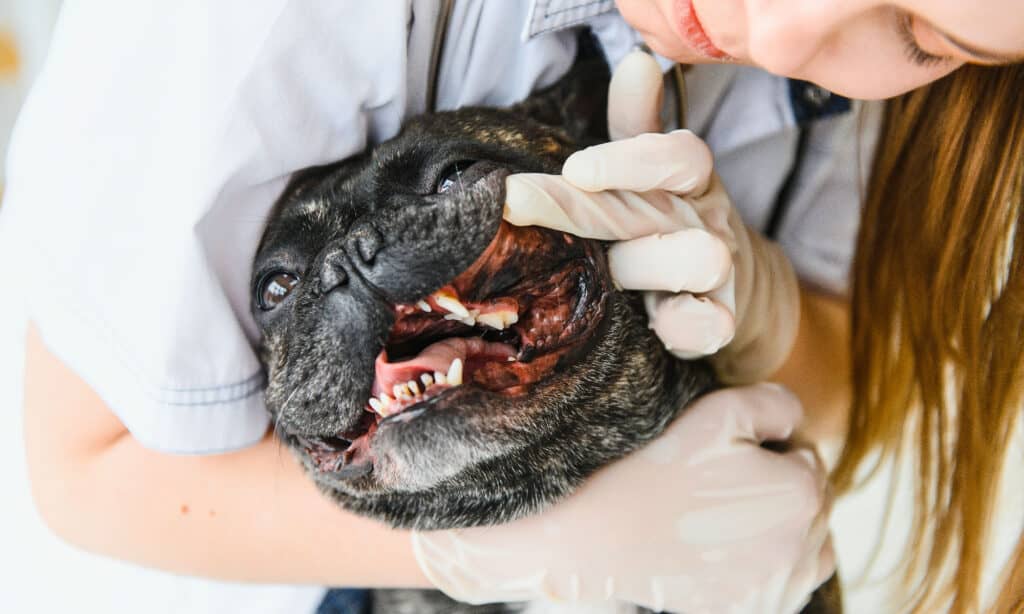
Periodontal disease is one of the most common infections in dogs.
©Hryshchyshen Serhii/Shutterstock.com
If you have a small dog you may have already endured a bout with a gum or tooth infection. Smaller breeds such as pugs, Yorkies, chihuahuas, and daschunds as well as collies and boxers are predisposed to periodontal disease due to a maligned bite, genetics, the shape of a dog’s mouth, or poor dental hygiene. It is caused by the accumulation of dental plaque and tartar on the teeth with symptoms beginning after your pup reaches age three.
Here are some signs to look out for:
- Bad breath
- Inability to chew kibble or treats
- Broken or missing teeth
- Excessive drooling
- Bleeding gums
- Change in behavior
- Favoring one side of the mouth
- Pawing at the mouth
- Inability to open or close the mouth
If you notice any of these behaviors in your dog – a trip to the vet is necessary. Antibiotics and pain medications can relieve symptoms and teeth scaling or extraction may be needed. Older dogs of all breeds are susceptible to periodontal disease but these problems seem to begin early for smaller dogs. The best treatment possible is to make teeth brushing a part of your new puppy’s routine as soon as she is adopted. If your dog requires grooming – teeth brushing is often offered as part of the package. Once periodontal disease progresses it becomes an endless cycle of pain medications, antibiotics and tooth extractions. Brushing your dog’s teeth is one of the best ways you can express your love for your sweet pet.
Summary Of The 9 Types Of Bacterial Infections In Dogs
| Rank | Viral Infection |
|---|---|
| 1 | Salmonella |
| 2 | Leptospirosis |
| 3 | Staph Infection |
| 4 | Ear Infection |
| 5 | Actinomycosis |
| 6 | Streptococcus |
| 7 | Clostridia |
| 8 | Bortedella |
| 9 | E. Coli |
The photo featured at the top of this post is © iStock.com/igorr1
Ready to discover the top 10 cutest dog breeds in the entire world?
How about the fastest dogs, the largest dogs and those that are -- quite frankly -- just the kindest dogs on the planet? Each day, AZ Animals sends out lists just like this to our thousands of email subscribers. And the best part? It's FREE. Join today by entering your email below.
Thank you for reading! Have some feedback for us? Contact the AZ Animals editorial team.






